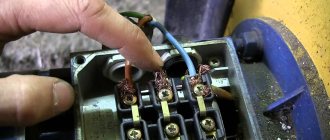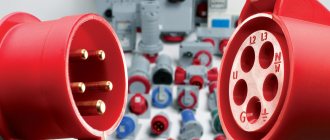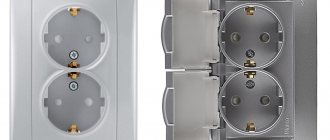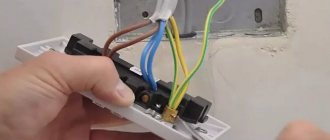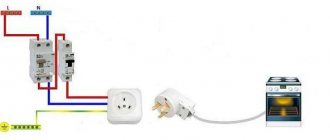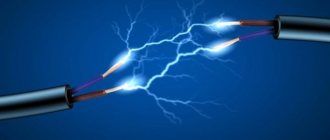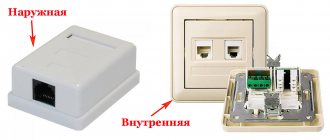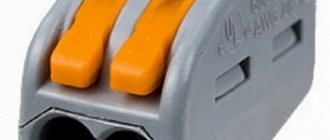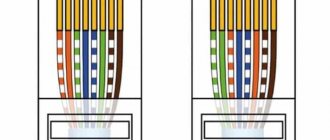Electrician in the house
Encyclopedia about electricity from A to Z
Masters catalog
Find the best master or company in your city
Sockets and plugs 380V
380V electrical sockets are widely used for connecting two-phase and three-phase power electrical equipment. These are mainly mobile electrical installations that require movement across the work area, or whose operation is only necessary periodically.
For stationary electrical installations, it is more advisable to use connections through switching devices capable of providing protection for electrical equipment and remote control of it.
- 380V sockets Types of 380V electrical sockets
- Features of 380V sockets
- Connecting 2P+PE and 3P+PE sockets
Types of sockets
Let's consider the known types of 380 Volt sockets? The connections of these sockets differ in shape, fastening method and the presence of contacts. The socket often contains from 3 to 5 connections.
In the CIS countries, three-phase voltage is used with 380 Volts. In an ordinary apartment, 220 Volts are used.
This indicator is obtained by connecting one of the three phases to the zero wire. To connect a 380 Volt industrial socket, you need to combine two phases with zero. This connection principle is used in a conventional electric stove.
Known standards for power connectors:
- 2P+PE – 2 phases and a single ground contact are used;
- 3P+PE – three power cables and one with grounding;
- 3P+N – 3 power contacts with one neutral;
- 3P+PE+N – 3 phases, 1 earth with zero.
The connections differ both in the number of contacts and in the construction of the housing. There is a cable structure designed to connect portable devices. Flange distributors are manufactured with fasteners, with the ability to be mounted directly into the wall or at an angle.
Another type is overhead models. Individual housings are equipped with an additional protective cap. There are models with protection against liquids: IP20, IP 44, IP 67; for 16, 32 and 63 amperes.
In the photo of a 380 Volt outlet you can see their differences and features.
It is important to note: a 380 V socket seems to be a highly dangerous structure, so any connections to it should be carried out by specialists, all connected units are advised to be grounded, and an additional device should be installed on the power line to the socket to protect the user from harm from electricity. It could be a differential machine.
Screw method of fastening the cores to the socket
In order to connect the conductors to the connector, you need to use one of the mounting options. The screw method is time-tested and very reliable. On the back of the socket there are screw terminals into which the ends of the cable are inserted and screwed to the contact. Before this, it is necessary to prepare the veins. Clean them with a sharp knife or a special tool for carefully removing insulation - a stripper. Put on the sleeve tips and crimp them with a hand tool - a crimper. If you don't have crimping pliers on hand, you can use a soldering iron and tin the twisted wires. Thus, the treated ends of the cable can already be screwed to the socket.
Methods for connecting sockets
The basis of each connection is the cable. It is worth choosing the right section, the required size and which can withstand a certain load.
- In accordance with GOST, for a socket voltage of 380 Volts with a current of 16 A, a wire with a profile of 1.5-4 mm is sufficient.
- The plug cable must be created with a minimum thickness of 1.5 to 2.5 mm. The thickness of the ground wire is 6 mm.
When installing connecting elements, you should listen to the instructions: the supply cable is a socket, and the receiving cable is a plug. When cleaning wires, do not break off or tangle the current-carrying wires. When a solid surface of the cable emerges, it will heat up less and transmit current better.
Voltage check
To make sure that the 380-volt socket is connected accurately, it is recommended to use a multimeter turned on in the AC voltage measurement mode and use the diagram.
Between phases in free sequence a value of 380 V should be observed. Between zero and each phase separately - 220 volts, and also between grounding (protective zero) and each phase - also 220 volts.
Only when all the values match can you start using the outlet to power electrical installations. In the event of a malfunction of energy consumers, the socket will perform the function of protection against electric shock.
There is another way to protect against current leakage - this is a special device called an RCD (residual current device). It is connected immediately after the power supply, and behind it there is a cable to the outlet. It will turn off as soon as a leak appears in the circuit and thereby prevent electric shock to a person.
By installing a differential circuit breaker, you can replace two devices - a power supply circuit breaker and an RCD, since it performs the functions of these elements of the electrical circuit. Usually, when from previous times only a circuit breaker is present in the wiring, specialists replace it with a differential circuit breaker and all issues with protection are resolved.
Four and five wire networks
- Installation of wires begins with disassembling the housing. The 380 Volt switching socket has 4 contacts, 3 of them are phase. Near the contacts you need to find the inscriptions L1, L2, L3 and freely connect 3 wires with a phase to them. Next you need to find the neutral wire and press it into the terminal marked with the letter N;
- To connect a connector with five contacts, a scheme similar to the previous one is used. The designation near the contacts is the same L1, L2, L3. Phase – N is zero and PE is ground. Switching on the ground will require an additional device - an RCD. This connection will help prevent electric shock when the housing or DIN rail becomes energized.
Switching on is carried out both with and without the connection of an RCD. It is important that a ground wire is present. The connection is made symmetrically, so the power cables can be combined in any order.
At the end of the installation work, you need to check that the connection is connected correctly and correct any defects.
Screwless mounting method
This is the most modern and convenient connection because it saves the electrician’s time, reduces labor costs and allows you to correct a connection error.
First, the cable is stripped, if necessary. For your information, sockets are produced where the insulation does not need to be removed; it is pierced with a special sharp clamp. The wire is then placed into the socket according to the 380 volt outlet diagram. The next step is to simultaneously press the lever and push the wire under the clamp, and then you just need to release the handle to fix the wire. Then you need to check the strength of the connection by pulling the cable.
There is a modification of the sockets, where instead of levers on each contact there are holes for a flat-head screwdriver. Then, placing the wire in the socket, insert a flat-blade screwdriver into the groove, and then lift the handle of the tool up. At this moment, the insulation will cut through. All that remains is to remove the screwdriver and check the strength of the contact by tugging on the cable.
Connecting a power outlet
Connecting a power outlet with your own hands is done according to the established rules:
- The current on the line where the working procedure will be performed is turned off. It is worth checking that there is no current using a multimeter or a screwdriver with a phase indicator;
- Three different phases are connected to the terminals with markers L1, L2, L3. The order of connecting the phases plays an important role when an electric motor is connected to the socket (when you need to change the direction of its rotation, swap arbitrary two phases of a machine or a starter with a magnet). In other situations, the order of the phases is arbitrary;
- Connect to the ground contact or RE - this is a protective conductor with grounding;
- The neutral wire is connected to the terminal marked N.
In Russia, 4-5 pin sockets and connectors of the RS 32, 115 brands have become more widespread. Foreign analogues should be installed with proper plugs for electrical appliances or for the sake of a beautiful interior.
How to connect a three-phase socket
After considering the theory, you can move on to direct practical actions. It is recommended to consider the standard connection of a three-phase outlet using the example of a typical power device. This socket is equipped with a protective cover and is used for external installation on wall surfaces. Regardless of the manufacturer, they are all standard and connect in the same ways. Three-phase power connectors are used not only with industrial equipment, but also at home to connect water heaters, electric boilers, fan heaters and other powerful devices.
Connection diagram
Now let's look at the introduction of wires to the terminals of the internal mechanism of the 380 Volt ABB plug.
Here the diagram for connecting the socket using contact pins is as follows:
- The wires should be connected to the mechanism fork terminals in accordance with the markings indicated on them;
- The wires are inserted into the three-phase plug according to the diagram. The terminal with zero is left empty. For other units where zero is required for operation, all wires are connected;
- The cleaned edges of the conductors are inserted into the terminal blocks and screwed in with mounting screws;
- The reliability and safety of the fastenings are checked, and then the power plug is assembled;
- The first step is to screw the housing onto the socket mechanism, providing protection for the contacts;
- Then the cable entry with a clamp is screwed onto the housing.
The design of such a plug or cable clamp is made in such a way that the tighter it is screwed, the more firmly the cable is secured in the socket.
This will allow you to connect 380 Volt plugs to equipment with power cables of different sections. A cable firmly pressed into the plug will serve as protection against inadvertent release of wires from the socket.
Plug-in connections for four-wire network
Electrical circuit diagram
In the old equipment grounding system, which used 4 wires to connect power to consumers according to the TN-C scheme, the metal body of the operating electrical appliance remained unconnected to anything. It was separated from the supplied voltage by a layer of insulation. It was strengthened for safety reasons.
However, the probability of breakdown of the dielectric layer remained. When it happened, a phase potential appeared on the body, which created a leakage current through the body of the person who touched it. A similar situation is described in detail in a separate article about three contacts for an electrical outlet.
Affected people felt “tingling”, felt convulsive muscle contractions, and in special cases received electrical injuries. A protection circuit consisting of a single circuit breaker or electrical plugs, as a rule, did not work in such a situation. The circuit breaker is designed to solve other problems.
Detachable connection design
To connect mobile electrical consumers to a three-phase network with a four-wire circuit, appropriate sockets and plugs were created.
The connection of the phase wires to their contacts was carried out almost arbitrarily, since the load between the phases is always symmetrical, and the order of their alternation affects only the direction of rotation of asynchronous electric motors.
It can be easily adjusted during setup by reconnecting two arbitrary phase wires anywhere. To do this, simply call the electrical wiring diagram.
The neutral working wire was always connected to its terminal. It was indicated by a grounding symbol.
It can be seen on the front side of the plug and socket.
Photo of connecting a 380 volt outlet
Share with friends
What is high voltage power used for?
For the same reason that main power lines operate under a voltage of 10 thousand volts. To provide a certain load (power of an electrical appliance), there are two ways: increase the current strength at a reduced voltage, or vice versa: by increasing the voltage, you can reduce the current in the circuit. To save power cables, it is more rational to supply the consumer with 380 volts instead of 220.
The benefit is obvious: the current is lower, the wires heat up less, and their cross-section can be reduced. Likewise, switching devices are designed for lower current.
Accordingly, to connect the final electrical installations, there must be a three-phase socket in the room.
Important! If you have a 3-phase socket installed in your house, connecting powerful single-phase consumers to it without specially switching the input terminals is prohibited!
In this case, load imbalance occurs, this negatively affects the operation of generating devices and can damage the protective automation.
How are phase wires connected?
If an electric heater or similar device that does not have an electric motor is connected to the outlet, then the order in which the phase wires are connected does not matter - the device will work in any case. When the connection diagram is intended for an electric motor, you must check whether it is spinning in the right direction. If rotation occurs in the opposite direction from the required one, then any two phase wires must be swapped - in the socket itself, on the plug or at the motor terminals.
Ideally, electricians should check the order of phase connections so that the same motor rotates in the same direction everywhere. In practice, such a device as an electric motor is installed permanently and it is much easier to swap contacts than to follow the connection diagrams. This is especially true for enterprises that have been operating for many years, and where these same circuits have already been repeatedly changed and reconnected to suit different needs.
Three-phase network device
Each 380V socket consists of at least 4 contacts: three phase wires and one neutral wire are suitable for it. The voltage between phases is 380 volts. A voltage of 220V is obtained if you measure it between any of the phases and zero. Each of the phases is capable of carrying a load of no less than three and a half thousand watts, and when connected together they can provide power to a load of up to ten and a half kilowatts or more, depending on need.
In each of the three phases, compared to the previous one, there is a movement of the sinusoid by an amount equal to one third of the period, which in total gives a total sinusoid voltage of 380 volts. How to use a multimeter to measure voltage, be sure to read the article on our website.
Such indicators are necessary, first of all, to supply power to electric motors, which can be used in a wide variety of areas. Obvious examples of such applications: winches that raise and lower elevator cars; lathes and other machines; ventilation systems and much more.
Important to know: a 3-phase socket can, if necessary, be used to produce a single-phase current of 220 volts. To do this, you need to connect two contacts on the plug connected to it: zero and any of the three phases. This way the required voltage will be obtained.
We correctly connect to the input device
First of all, let's deal with color coding. The power cable for three-phase connection may have European colors, or comply with the Electrical Installation Rules. In the first case, the phases are marked with brown, white (gray) and black shell colors. In the second - (which is unlikely for residential buildings), yellow, green and red. The cables have one thing in common: just like in a single-phase system, the working zero will be blue (blue), and the protective ground will be yellow with a green stripe along the length of the wire.
After the three-phase meter (electricity meter), a four-way automatic machine must be installed. It is on line 4: since both phases and zero must be turned off if necessary.
Important! The protective grounding is inserted into the socket without the possibility of it being broken by the switching device (automatic machine)!
In principle, the binding of specific lines to contact numbers is not defined by any instructions. Each user himself determines exactly how to connect a three-phase outlet.
According to unspoken rules, on a four-pin socket (for example), the working zero is located on the right.
And on the 5-pin (with protective grounding) in the center.
For an outdoor outlet protected from dust and moisture, there is also a standard line layout.
And yet, three-phase consumers are connected to the power point individually; there can be no universality. If you are commissioning an electric stove, there are several power supply options on the input connection block: 220 or 400 volts.
By default, jumpers may be installed that will lead to a short circuit between phases. Therefore, you should first study the instructions for the electrical installation, and then plan the location of the contacts in the outlet.
Installations with three-phase electric motors have their own power supply. Again, we return to the basic rule: no universality.
